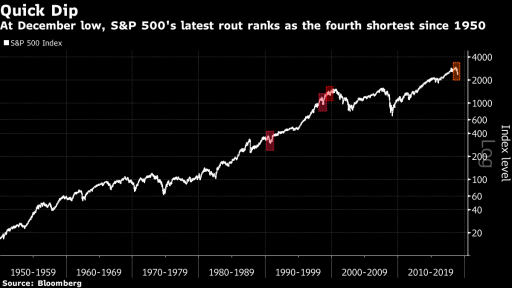- Home
- >
- Daily Accents
- >
- Do not rush with buying the dip on S&P500, bottom formation can take time

Do not rush with buying the dip on S&P500, bottom formation can take time

Are you convinced that the sale of the markets is over? Surely at times we had this feeling. At moments like last Friday when the Dow Jones Industrial Average climbed almost 750 points. However, the isolated cases of market hurdles do not impress traders and investors to the maximum that they believe that the expected buy the dip moment has come.
But even in a good scenario - where the bear market is totally avoided and the Christmas Rally has happened - it would be wise to remember that the S & P500 bottoms are formed much slower than before.
Since 1950, the S & P500 has experienced 11 releases worth 12% or more that have occurred in a prolonged bull market like the one we are still in. The average drops were 19.9%, which corresponds to the last, which started last October. Corrections usually last longer - an average of eight months.
In other words, even if we approach a bottom based on price level in the stock, it may still be premature to declare that "the horizon is pure" if we take the story. As much as the bulls hope Donald Trump is right - that the worst December of the Great Depression was "just a bug", the market patterns of the past suggest that things are not that simple.
From the trade tensions between the US and China to the uncertainty surrounding the Fed's monetary policy, the problems faced in the last quarter of 2018 have not yet gone. Meanwhile, bad news continues to make their way. Apple and Delta Air have joined the growing list of companies that are beginning to cut their financial forecasts, boosting fears of economic slowdown in 2019, and that corporate profits may be less than predicted by analysts.
The S & P500 came back several times to test the bottom of the 10% drops in October and November and did not withstand bearish pressure. Now the previous levels of support have become fierce resistances.
The range between 2 530 and 2 600 is a rather powerful resistance to the S & P500. After the failed attempts to pass over 2 530 on December 28 and again on January 2, the S & P500 finally broke the limit last Friday. Still, at 2,531.94 stands the bottom of last February. Passing less than 2,200 in the first quarter of 2019 will be an expected event if bears take full control.
Source: Bloomberg Finance L.P.
Graphs: Used with permission of Bloomberg Finance L.P.
 Trader Martin Nikolov
Trader Martin Nikolov Read more:
If you think, we can improve that section,
please comment. Your oppinion is imortant for us.













